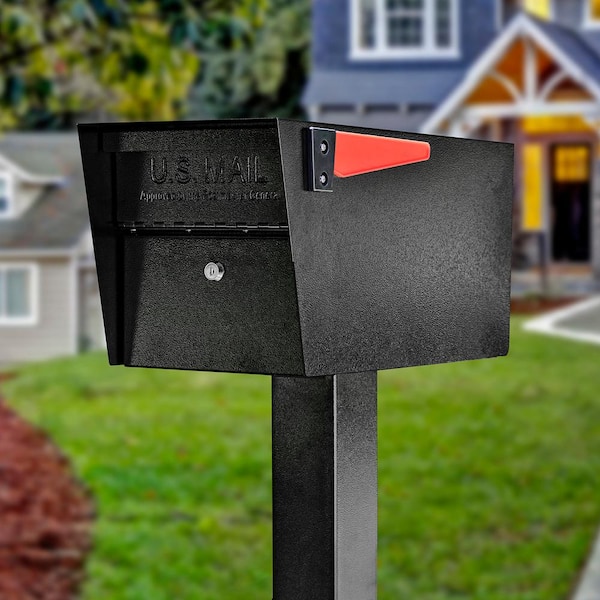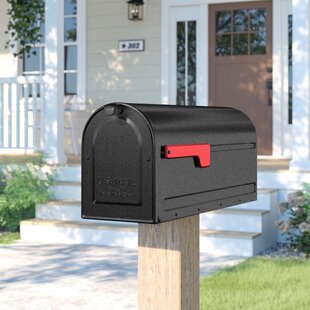The Epoch design locking drop box is a wall mounted mailbox that is made of heavy gauge 16-gauge powder-coated steel and features a patented anti-pry latch locking mechanism used to prevent theft. This secure drop box features an anti-fishing Bin door that accepts letters, checks, and small bundles. Our anti theft post boxes will help protect your mail & ID. With a secure lock, anti fishing baffle to the aperture & robust steel construction these are the toughest mailboxes around. Designed to combat instances of mail and ID theft, these anti theft mailboxes are the most secure multi-unit apartment-style letterboxes available in the UK.
Less than three months before the November presidential election, a national battle is playing out over the future of the U.S. Postal Service and its ability to process mail-in ballots.
Postal worker union members say mailboxes have been removed from locations in the Bronx and mail is piling up as well. At stake, critics fear that mail-in ballots may not arrive in time to be counted in the upcoming election.
Over the weekend, dozens of blue mailboxes were seen discarded behind a post office in the Bronx. The American Postal Workers Union says those boxes removed and held at the Cornell Post Office were not being replaced.
In Trenton, New Jersey, mail was snapped piling up at a sorting facility. And in Morristown, a flatbed truck drew attention for hauling away a number of mailboxes Saturday morning.
'The Morristown Mayors office has been informed that a truck has been seen driving throughout town today with several US Postal Service Boxes in its truck bed. Our office has NOT been informed about any scheduled removals, changes or box replacements,' read a Facebook post from the Town of Morristown.


News
Post Box Ireland
Rep. Mikie Sherill (D-NJ) promised an investigation into the removal of boxes, tweeting, 'I'm not going to sit by while the USPS -- and essential service -- is systematically dismantled here in NJ and around the country.'
In a statement, the USPS said that it was aware of the concern regarding the removal of mailboxes, but said that 'collection box movement can be part of routine maintenance, as seen in some pictures circulating in the New York area this weekend.' The service said that some older blue boxes seen in towns may be taken out in favor of one with more security.
'The Postal Service reviews collection box density every year on a routine basis to identify redundant or seldom used collection boxes as First-Class Mail volume continues to decline,' the statement read. 'Based on the density testing, boxes are identified for potential removal and notices are placed on boxes to give customers an opportunity to comment before the removal decision is made.'
The USPS said there are 'no plans to remove collection boxes and no collection boxes in the area have been removed without notice.'
Changes to the U.S. Postal Service prompted a dire warning from the president of the NY Metro Area Postal Union.
'Every facility that I represent, the mail is backing up, it's piling up more and more. It's definitely intentional and its going to hurt the American public in the long run,' said Jonathan Smith, the union's president.
Last week the USPS sent letters to dozens of states and Washington, D.C. saying it cannot guarantee all ballots cast by mail will arrive in time to be counted.
As accusations intensify that longtime Trump ally, Postmaster General Lewis DeJoy is making it harder for Americans to vote by mail during the pandemic. By eliminating overtime for many workers and deactivating hundreds of mail sorting machines.
For weeks the president has argued without any evidence that voting by mail is subject to widespread fraud.
'Universal mail-in voting is going to be catastrophic. It's going to make our country a laughing stock all over the world,' Trump has claimed.
Democrats said delays hurt more than voting.
'It will hurt our seniors, our veterans, others that depend on their medications by mail, their packages, other deliveries. And these delays are also happening across our country,' said Rep. Carolyn Maloney (D-NY).
The USPS has promised to stop the removal of any mailboxes until after the election. Still, the local postal union is worried.
'The postal workers do not want to be political. We do not deliver Democratic mail or Republican mail, we deliver all the mail. We just want to do our jobs like we've always done our jobs, and he's taking our ability to serve the American people away,' Smith said.

Sept. 5, 2019
Try Norton 360 FREE 30-Day Trial* - Includes Norton Secure VPN
30 days of FREE* comprehensive antivirus, device security and online privacy with Norton Secure VPN.
*Terms Apply
A phishing scam is a type of fraud that can come in many different forms. These scams not only employ various online techniques such as fake emails and pop-up ads but can also include phone calls. The people behind these scams often use fear tactics in order to get their victims to take the bait.
Phishing is essentially an online con game, and phishers are nothing more than tech-savvy con artists and identity thieves. They use spam, malicious websites, email messages, and instant messages to trick people into divulging sensitive information. Banking information, credit card accounts, usernames, and passwords are just some of the information phishers seek to exploit.
5 common phishing scams, and how to protect yourself from them
Since phishing scams are designed to appear as if they come from reliable sources, it is smart to know the difference between real and fraudulent messages and how to spot some of the clues that a message may be a scam. Here is a list of five common phishing scams and ways to help protect yourself against falling for them.
1. Email phishing scams
An email phishing scam is a fraudulent email message that appears to be from a person or company known to the victim. It attempts to illegally gather personal and/or financial information from the recipient.
A phishing message typically includes at least one link to a fake website, designed to mimic the site of a legitimate business. The message entices the recipient to provide information that could be used for identity theft or online financial theft.
How to help protect yourself against email phishing scams:
- Do not click any links or download any attachments in the suspicious email. Instead, open up your web browser and go to the website in question by typing it into the URL bar.
- Be vigilant and pay attention. Phishers have been known to use real company logos to make their communications seem legitimate. They also use spoofed email addresses, which are similar to the actual company’s address. However, the address may be misspelled slightly or come from a spoofed domain.
2. Vishing scams
Vishing (voice or VoIP phishing) is the voice version of email phishing. “V” stands for voice, but otherwise, the scam attempt is the same. It is a phone scam in which individuals are tricked or scared into handing over valuable financial or personal information to scammers.
How to help protect yourself against vishing scams:

- Never give personal information over the phone. Hang up, look for the number of the company on their website, and call them directly to make sure it was a legitimate call and request.
- Never call the number the caller provides. When looking up the company website, make sure it is legitimate. Fake websites often contain misspellings and other telltale signs.
3. Tech support cold call scams
Tech support cold calls are when a scammer calls a potential victim claiming to be from a reputable security company. They lie and say they found malware on the victim’s computer.
The criminal pretends to offer a solution by getting the user to install a type of remote desktop software. This allows the attacker access to the computer in order to install real malware. In addition to attempting to install malware on the machine, these scammers will often ask for a fee to “fix” the issue.
How to help protect yourself against tech support call scams:
- If a person calls claiming to work for a specific, well-known company, look up the phone number online and tell them you will call them back.
- Never allow remote access to your computer.
4. Pop-up warning scams
Pop-ups occur when someone is browsing the internet and sees a small graphic or ad appear on their screen. Usually, pop-ups are related to the content being viewed and link to another website with similar content or merchandise related to the content.
Malicious pop-ups can be terribly intrusive, making it difficult for the user to close the pop-up window. These pop-ups may display a message stating that the computer is infected with malware and offer a phone number for help with removing the malware. Often, the cybercriminals make pop-ups look like they come from a trusted source, such as our own Norton products, in hopes of appearing to be legitimate.
How to help protect yourself against pop-up scams:
- Examine the message closely. Look for obvious signs of fraud such as poor spelling, unprofessional imagery, and bad grammar.
- Remember, when in doubt, never click on the pop-up. Instead, open up your antivirus software and run a system scan.
- Norton pop-ups will only appear within the interface of the Norton Security Dashboard, and never from a web browser or other program. In addition, Norton customer support will never send users unsolicited pop-ups stating that they will fix a user’s computer if given remote access.
5. Fake search results scams
Fraudulent companies frequently use paid search ads for their “support services” as if they were legitimate, well-known companies. These paid listings can appear at the top of a search results page, a prime location. These results, which can look like the real thing, can promise support offers that seem too good to be true in hopes of luring in a victim, whose top concern is to fix their computer. Unfortunately, when you click on the ad, malware may begin to download to your device, compromising the security of your information and adding to your computer woes.
How to help protect yourself against fake search results scams
- Examine the URL closely. Creators of fake websites will sometimes try something called typo squatting, where they register a domain name that looks similar to the URL of the legitimate site they’re duplicating.
- Use a secure search service, such as Norton Safe Search, to know if the site you’re about to visit is safe.
What to do if you’ve been scammed
If you think you’ve been the victim of a phishing scam:
- Change your passwords. Your computer, financial institutions, your Norton Account, and any other password-protected websites that you visit should be updated.
- Run a Full System Scan for viruses on your computer.
- Contact your bank to report that you may have been the victim of fraud.
- Use Norton Power Eraser to scan your computer. It can help detect more complex threats than a traditional antivirus program may be able to.
Try Norton 360 FREE 30-Day Trial* - Includes Norton Secure VPN
30 days of FREE* comprehensive antivirus, device security and online privacy with Norton Secure VPN.
*Terms Apply
Post Box Singapore
Editorial note: Our articles provide educational information for you. NortonLifeLock offerings may not cover or protect against every type of crime, fraud, or threat we write about. Our goal is to increase awareness about cyber safety. Please review complete Terms during enrollment or setup. Remember that no one can prevent all identity theft or cybercrime, and that LifeLock does not monitor all transactions at all businesses.
Copyright © 2021 NortonLifeLock Inc. All rights reserved. NortonLifeLock, the NortonLifeLock Logo, the Checkmark Logo, Norton, LifeLock, and the LockMan Logo are trademarks or registered trademarks of NortonLifeLock Inc. or its affiliates in the United States and other countries. Firefox is a trademark of Mozilla Foundation. Android, Google Chrome, Google Play and the Google Play logo are trademarks of Google, LLC. Mac, iPhone, iPad, Apple and the Apple logo are trademarks of Apple Inc., registered in the U.S. and other countries. App Store is a service mark of Apple Inc. Alexa and all related logos are trademarks of Amazon.com, Inc. or its affiliates. Microsoft and the Window logo are trademarks of Microsoft Corporation in the U.S. and other countries. The Android robot is reproduced or modified from work created and shared by Google and used according to terms described in the Creative Commons 3.0 Attribution License. Other names may be trademarks of their respective owners.
No one can prevent all identity theft or cybercrime. Not all products, services and features are available on all devices or operating systems. System requirement information on norton.com.
*Important Subscription, Pricing and Offer Details:
- The price quoted today may include an introductory offer. After that, your membership will automatically renew and be billed at the applicable monthly or annual renewal price found here.
- You can cancel your subscription at my.norton.com or by contacting Member Services & Support. For more details, please visit the Refund Policy.
- Your subscription may include product, service and /or protection updates and features may be added, modified or removed subject to the acceptance of the Customer Agreement.
Wedding Post Box
The number of supported devices allowed under your plan are primarily for personal or household use only. Not for commercial use. If you have issues adding a device, please contact Member Services & Support.
Anti Fishing Post Box Plans
§ Dark Web Monitoring in Norton 360 plans defaults to monitor your email address only. Please login to the portal to review if you can add additional information for monitoring purposes.
